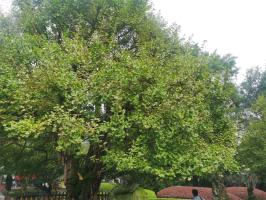How Much CO2 Will Newly Planted Trees Remove?
Climate change is one of the biggest challenges the world is currently facing. One of the main drivers of climate change is the increasing concentration of carbon dioxide (CO2) in the atmosphere. Trees have been proven to be one of the most effective natural tools for removing CO2 from the atmosphere. But just how much CO2 can newly planted trees remove? Let's explore this question further.
The Role of Trees in Carbon Sequestration
Trees are natural carbon sinks, meaning they absorb and store carbon from the atmosphere. Through the process of photosynthesis, trees take in CO2, water, and sunlight, and convert them into oxygen and carbohydrates. The oxygen is released back into the atmosphere, while the carbohydrates are stored in the tree's biomass, such as its trunk, branches, and leaves. Over time, these stored carbohydrates become part of the soil, where they can remain for decades or even centuries.
The amount of carbon that a tree can sequester depends on various factors, such as the species of the tree, its age, and the environment in which it grows. Generally, younger trees sequester more carbon than older trees, as they are still growing rapidly and accumulating biomass. However, as trees age, their growth rate slows down, and they eventually reach a point where their carbon uptake rate plateaus.
The Calculation of CO2 Reduction by Newly Planted Trees
Calculating the amount of CO2 that newly planted trees can remove is a complex process that depends on multiple factors. These factors include the species of the tree, its age, its location, and the density of the forest. In general, one mature tree can absorb between 48 and 240 pounds of CO2 per year, depending on its species and geographic location.
According to studies, a forest of one hectare (2.47 acres) could sequester around 6.2 metric tonnes of CO2 per year once mature. This is equivalent to the amount of CO2 produced by driving a car around 15,000 miles. However, it is important to note that newly planted trees have a lower rate of carbon sequestration than mature trees, so their CO2 reduction potential is lower.
The Benefits of Planting Trees
Despite the lower carbon sequestration rate of newly planted trees, planting trees remains a critical tool for mitigating climate change and its adverse effects. Trees provide numerous environmental, economic, and social benefits to the communities where they are planted. They help to combat soil erosion, filter pollutants from the air and water, provide habitat for wildlife, and improve the visual aesthetics of cities and towns.
In addition to these environmental benefits, planting trees can also have a positive impact on the economy. Trees provide a source of timber and other forest products, which can support local businesses and create jobs. Furthermore, adequate tree cover can reduce energy costs by providing shade and reducing the need for air conditioning.
The Bottom Line
While the exact amount of CO2 that newly planted trees can remove is difficult to calculate, it is safe to say that planting trees is an effective tool for reducing carbon emissions and mitigating the effects of climate change. However, planting trees should not be viewed as a stand-alone solution to the climate crisis. In addition to planting trees, we need to work towards reducing our CO2 emissions from all sectors and transitioning towards a more sustainable and climate-friendly way of life.
At the end of the day, it is up to each one of us to do our part in protecting our planet from the adverse effects of climate change. Planting trees is one small step we can all take towards a healthier and more sustainable future.

 how many times do yo...
how many times do yo... how many planted tre...
how many planted tre... how many pine trees ...
how many pine trees ... how many pecan trees...
how many pecan trees... how many plants comp...
how many plants comp... how many plants can ...
how many plants can ... how many plants and ...
how many plants and ... how many pepper plan...
how many pepper plan...






























